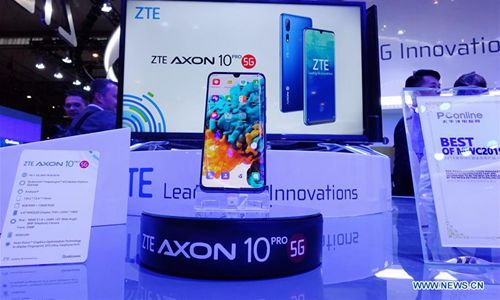HOME >> BUSINESS
ZTE to invest more on R&D of 5G chip and edge computing
Source:Global Times Published: 2019/5/30 20:53:40

China's ZTE presents its Axon 10 Pro 5G cellphone at Mobile World Congress (MWC 2019) in Barcelona, Spain, Feb. 26, 2019. The four-day MWC 2019 opened its door on Monday, which presents the newest 5G products of the high-tech giants from all around the world. (Xinhua/Guo Qiuda)
ZTE is set to invest more than 10 percent of its sales revenue on research and development (R&D) focusing on 5G chips and edge computing, said ZTE President Xu Ziyang at the annual shareholders' meeting on Thursday.
Industry analysts said independent R&D is essential to overcome US bans on exports from suppliers.
Last year, R&D investment accounted for 12 percent of its revenue, according to a statement ZTE sent to the Global Times on Thursday.
ZTE will focus on the upgrading of 5G chips and end-to-end solutions.
Sanechips Technology Co, a subsidiary of ZTE Corp, focuses on telecom technologies and aims to become a leading chip supplier.
Xu said the core competitiveness of ZTE lies in chips, patents and software, and Sanechips targets 5-nanometer systems-on-chips, a step up from the present technology, according to the statement. ZTE will continue to focus on R&D for chips to avoid relying on exclusive supplies. This is a way to eliminate uncertainty.
The inclusion of Huawei among 140 Chinese entities on a US trade blacklist has affected the whole industry, said Xu, but ZTE can overcome the influence through its own efforts.
In addition to investing in chips, ZTE will put efforts into edge computing. It recently announced the signing of an agreement with Tencent on 5G network technology and application innovation to boost the application of edge computing and the 5G industry.
Edge computing is one of the core technologies of 5G services, which enables virtual networks to come closer to users to reduce service access delays and the cost of network transportation.
As for overseas business, the system is recovering very well and it is making good progress in close and good cooperation with major operators around the world, said Xu.
The US placed export sanctions on ZTE in 2016, which meant a ban on procurement of chips and technical support from US suppliers. After a year of negotiations, ZTE paid heavy fines in a settlement with the US government to end the long-running export control case. Affected by the ban, ZTE suffered a loss of nearly 7 billion yuan ($1.01 billion) in 2018 but gradually recovered in the first quarter of 2019, according to its latest financial report, which showed a net profit of 863 million yuan, up 115.95 percent year on year.
"ZTE had to pay that unreasonable penalty for a baseless sanction because it relied on US chips," Xiang Ligang, an industry observer, told Global Times on Thursday. "Now it can achieve complete independent development of chips for telecommunication and computing. That's huge progress."
Last week, a bipartisan group of US lawmakers introduced legislation to "provide about $700 million in grants to help US telecommunications providers with the cost of removing Huawei equipment from their networks," Reuters reported.
The bill also moves to block services from both Huawei and ZTE in the next-generation 5G networks, Reuters reported.
"The hysteria is not going to work," Xiang commented. "The subsidy is not enough to replace all Huawei and ZTE equipment. What's more, Huawei and ZTE are leaders in 5G equipment and network."
5G is the next generation of mobile network technology that will improve the mobile experience and internet speeds.
"If US telecom operators abandon Chinese equipment and services, they will suffer from lags in technology," Xiang added.
Posted in: INDUSTRIES,COMPANIES